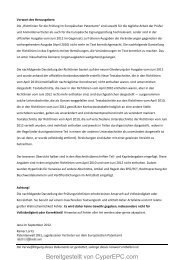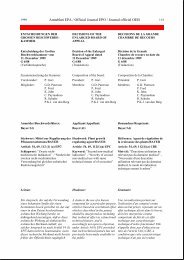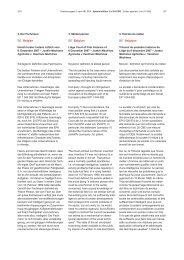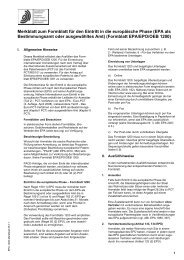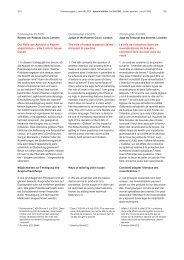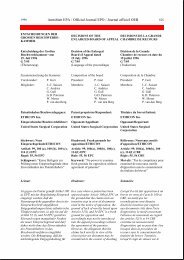Case Law from the Contracting States to the EPC 2004 ... - CyberEPC
Case Law from the Contracting States to the EPC 2004 ... - CyberEPC
Case Law from the Contracting States to the EPC 2004 ... - CyberEPC
You also want an ePaper? Increase the reach of your titles
YUMPU automatically turns print PDFs into web optimized ePapers that Google loves.
56 Sonderausgabe 3 zum ABl. EPA Special edition 3 of OJ EPO Edition spéciale 3 du JO OEB 2011<br />
technischen Verfahrens zusammenarbeiten.<br />
Denn in diesem Fall besteht<br />
gewöhnlich ein gemeinsames Interesse<br />
aller Beteiligten, die Erfindung Dritten<br />
gegenüber geheim zu halten. Der OPM<br />
kam zu dem Ergebnis, dass ein solcher<br />
Fall hier vorlag.<br />
Zu den Versuchsbaustellen:<br />
Durch Benutzung wird ein Patent dann<br />
der Öffentlichkeit zugänglich, wenn<br />
dadurch für einen nicht beschränkten<br />
Personenkreis eine nicht entfernt<br />
liegende, d.h. nicht bloß <strong>the</strong>oretische<br />
Möglichkeit der Kenntnisnahme entsteht.<br />
Betrifft das Patent die Zusammensetzung<br />
eines Erzeugnisses, so liegt eine<br />
neuheitsschädliche Offenbarung dann<br />
vor, wenn das Erzeugnis selbst der<br />
Öffentlichkeit zugänglich ist und von<br />
einem Fachmann analysiert und reproduziert<br />
werden kann. Die Möglichkeit,<br />
das neuartige Erzeugnis zu betrachten,<br />
begründet demgegenüber (nur) dann<br />
öffentliche Zugänglichkeit, wenn ein<br />
Fachmann schon durch bloßen Augenschein<br />
die technischen Zusammenhänge<br />
erkennt. Der OPM kam zu dem Ergebnis,<br />
dass bei Verfüllmaterial, das auf<br />
Baustellen eines öffentlichen Auftraggebers<br />
eingesetzt wird, nur eine <strong>the</strong>oretische<br />
Möglichkeit der Kenntnisnahme<br />
bestand.<br />
Das Gericht führte in Bezug auf die Neuheit<br />
aus, dass laut B die Erfindung nicht<br />
neu sei, weil es bereits mehrere auf der<br />
Wirkung von Infrarotstrahlung beruhende<br />
Anwendungen des Verfahrens gegeben<br />
habe, welches die Reduzierung des Körprocess<br />
because, in that case, all those<br />
involved had a shared interest in keeping<br />
<strong>the</strong> invention secret <strong>from</strong> third parties.<br />
The Supreme Patent and Trademark<br />
Chamber concluded that this was such a<br />
case.<br />
On <strong>the</strong> test building sites:<br />
A patent was made available <strong>to</strong> <strong>the</strong><br />
public by use if said use gave an unrestricted<br />
group of people more than just a<br />
<strong>the</strong>oretical possibility of gaining knowledge<br />
of it. If <strong>the</strong> patent related <strong>to</strong> <strong>the</strong><br />
composition of a product, a disclosure<br />
was novelty-destroying if <strong>the</strong> product as<br />
such was available <strong>to</strong> <strong>the</strong> public and<br />
could be analysed and reproduced by<br />
<strong>the</strong> skilled person. In contrast, <strong>the</strong> possibility<br />
of observing <strong>the</strong> new product made<br />
it available <strong>to</strong> <strong>the</strong> public (only) if a skilled<br />
person could identify <strong>the</strong> technical correlations<br />
<strong>from</strong> a mere visual inspection.<br />
The Supreme Patent and Trademark<br />
Chamber concluded that only a <strong>the</strong>oretical<br />
possibility of gaining knowledge<br />
existed in <strong>the</strong> case of filling material<br />
used on <strong>the</strong> building sites of a public<br />
contracting authority.<br />
la mise à l'essai d'un nouveau procédé<br />
technique. En effet, dans ce cas, il existe<br />
d'ordinaire un intérêt commun de <strong>to</strong>utes<br />
les parties intéressés à maintenir secrète<br />
l'invention vis-à-vis des tiers. La Chambre<br />
suprême des brevets et des marques<br />
a conclu que c'était ici le cas.<br />
Concernant les chantiers d'essai :<br />
Un brevet est rendu accessible au public<br />
par un usage si, de ce fait, un cercle non<br />
limité de personnes a eu la possibilité<br />
réelle, c'est-à-dire non purement théorique<br />
d'en prendre connaissance. Si le<br />
brevet porte sur la composition d'un<br />
produit, il y a divulgation destructrice<br />
de la nouveauté quand le produit<br />
lui-même a été rendu accessible au<br />
public et qu'un homme du métier pouvait<br />
l'analyser et le reproduire. En revanche,<br />
la possibilité de voir le nouveau produit<br />
ne signifie l'accessibilité au public que si<br />
un homme du métier reconnaît les spécificités<br />
techniques par simple inspection<br />
visuelle. La Chambre suprême des<br />
brevets et des marques en a tiré la<br />
conclusion que, dans le cas d'un<br />
matériau de remplissage utilisé sur des<br />
chantiers commandités par des pouvoirs<br />
publics, il n'y avait qu'une possibilité<br />
théorique d'en prendre connaissance.<br />
BE Belgien<br />
Gericht erster Instanz Brüssel vom<br />
19. Dezember 2008 – Lefebvre<br />
v. Bogaert<br />
Schlagwort: Neuheit – im Internet<br />
offenbarter Stand der Technik<br />
L war Inhaberin eines belgischen<br />
Patents für ein "Thermodermie-Gerät,<br />
das der Massage und der Reduzierung<br />
des Körperumfangs dient". Das Patent<br />
betraf ein Gerät zur Anwendung eines<br />
physio<strong>the</strong>rapeutischen Verfahrens, bei<br />
dem die Haut angesaugt und gleichzeitig<br />
ein Bündel starker Rot- und Infrarotstrahlung<br />
hineinprojiziert wurde, das die<br />
Lipolyse der Fettzellen auslöste.<br />
BE Belgium<br />
Brussels Court of First Instance of<br />
19 December 2008 – Lefebvre<br />
v Bogaert<br />
Keyword: novelty – prior art disclosed on<br />
internet<br />
L was <strong>the</strong> proprie<strong>to</strong>r of a Belgian patent<br />
for a "<strong>the</strong>rmodermal massaging and<br />
slimming device". This patent concerned<br />
a device which applied a procedure<br />
intended for physio<strong>the</strong>rapy that involved<br />
drawing up <strong>the</strong> skin while at <strong>the</strong> same<br />
time injecting in<strong>to</strong> it a high-power red and<br />
infrared beam <strong>to</strong> bring about <strong>the</strong> lipolysis<br />
of fat in adipose tissue.<br />
With regard <strong>to</strong> novelty, <strong>the</strong> Court noted<br />
that B asserted that <strong>the</strong> invention was<br />
not novel because several slimming<br />
applications based on <strong>the</strong> power of<br />
infrared rays were already in existence.<br />
In support of this assertion, B cited<br />
BE Belgique<br />
Tribunal de première instance de<br />
Bruxelles du 19 décembre 2008 –<br />
Lefebvre c. Bogaert<br />
Mot-clé : nouveauté – antériorité<br />
divulguée sur internet<br />
L est titulaire d'un brevet d'invention<br />
belge pour un "dispositif <strong>the</strong>rmodermique<br />
de massage et d'amaigrissement". Ce<br />
brevet d'invention concerne un appareil<br />
appliquant un procédé destiné à la<br />
physiothérapie consistant à aspirer la<br />
peau et à y injecter de manière concomitante<br />
un faisceau rouge et infrarouge de<br />
forte puissance initiant la lipolyse des<br />
adipocires.<br />
Quant à la nouveauté de l'invention, le<br />
Tribunal énonce que B soutient que<br />
l'invention ne serait pas nouvelle parce<br />
qu'il existait déjà plusieurs applications<br />
du procédé d'amaigrissement basées<br />
sur les pouvoirs des rayons infrarouges.



